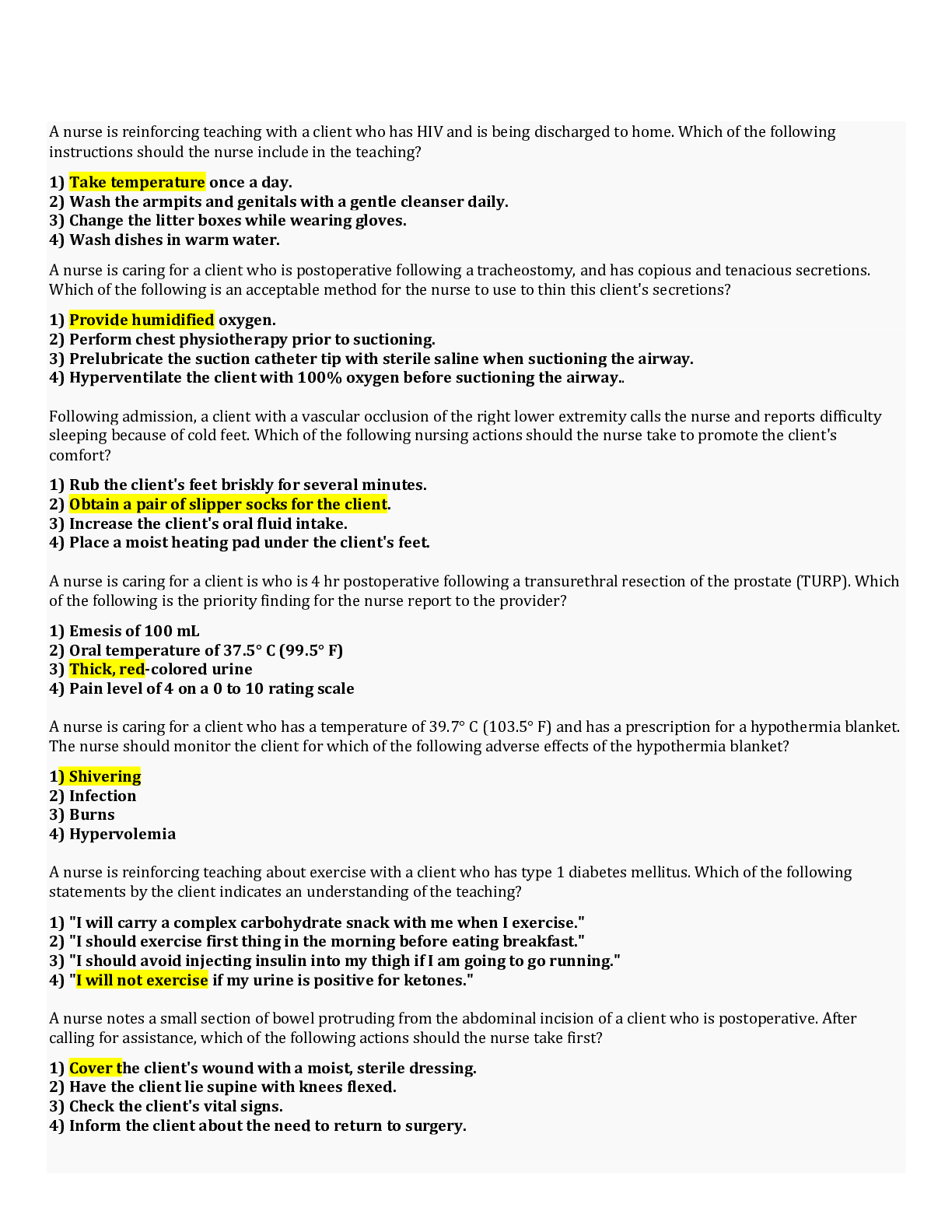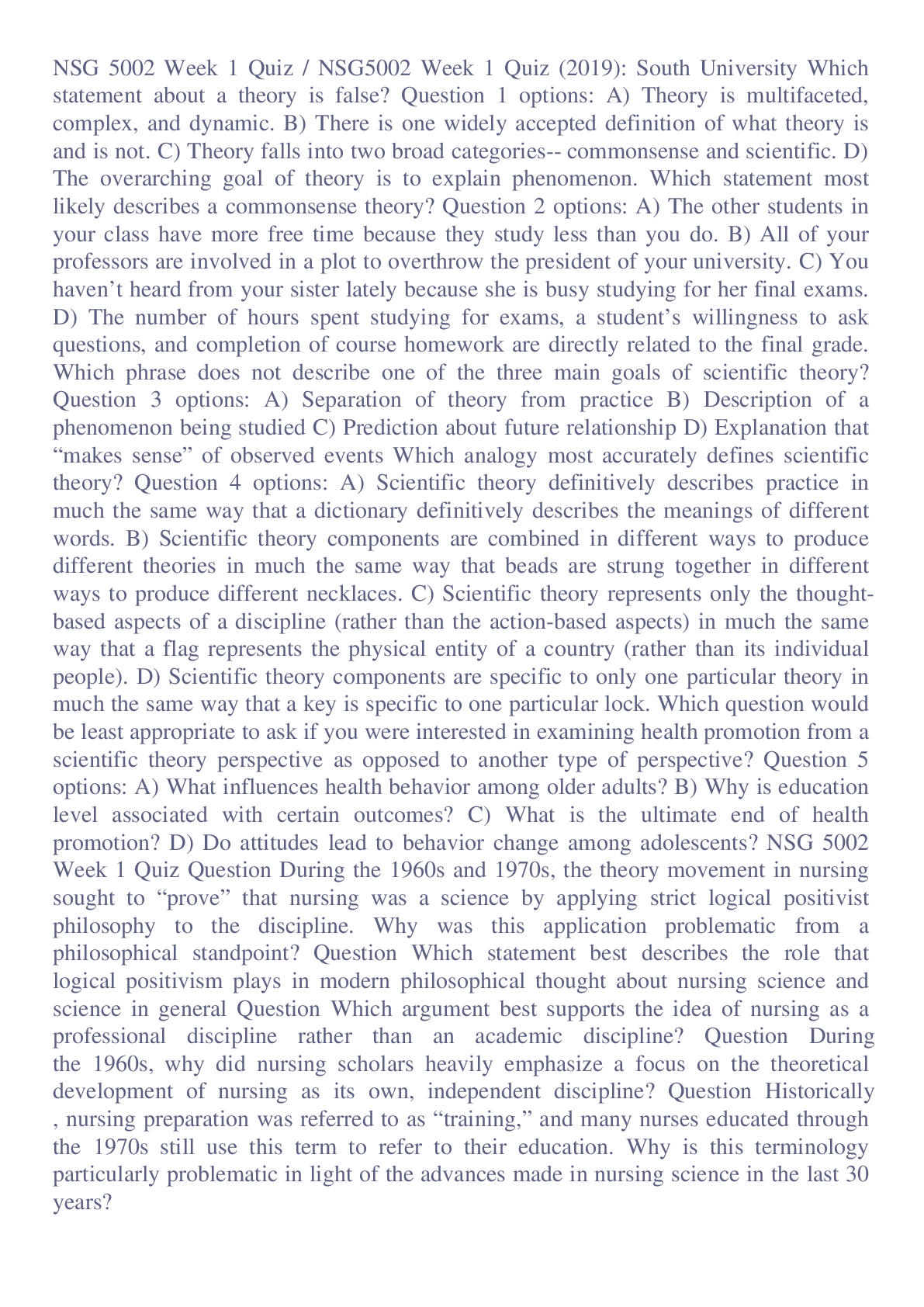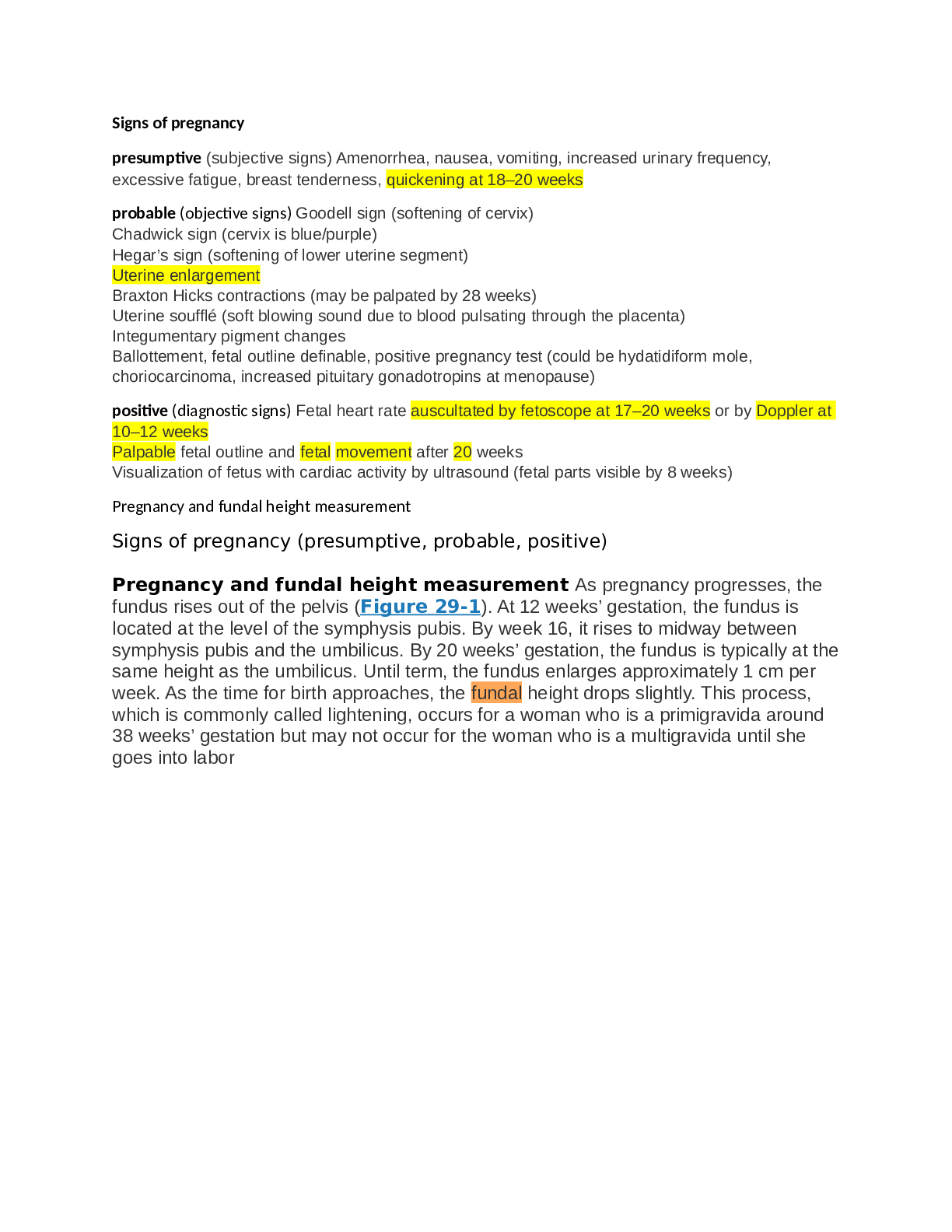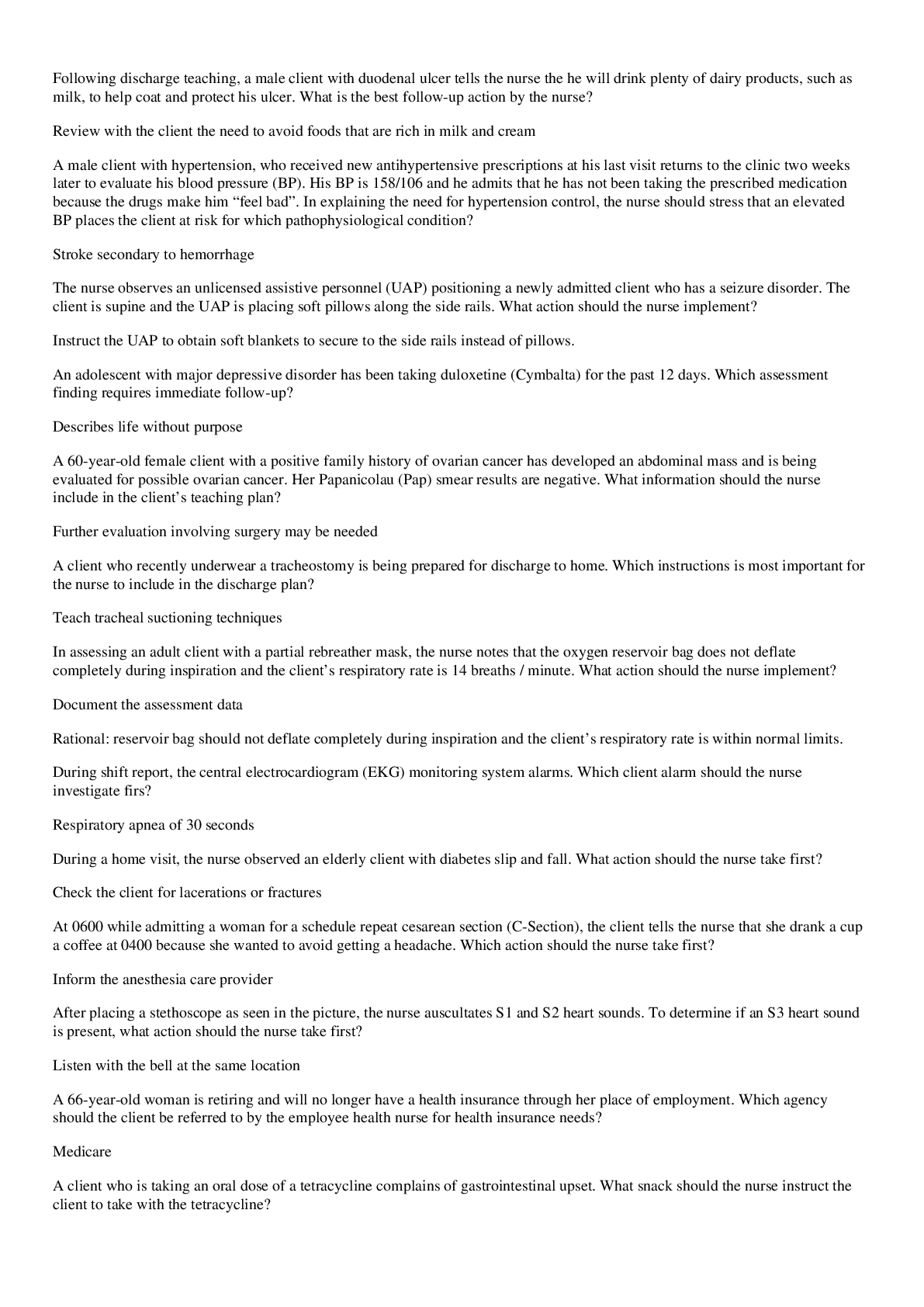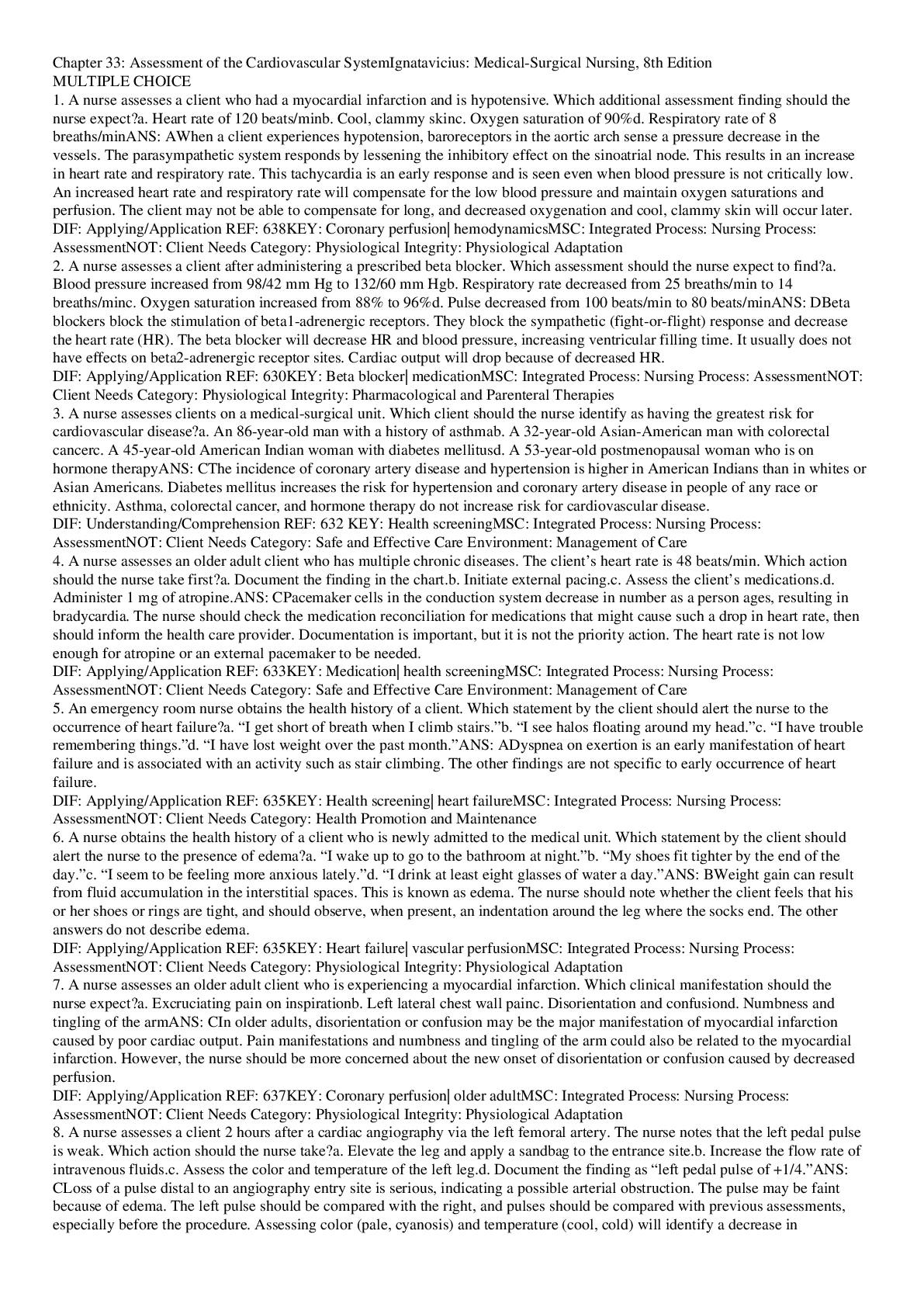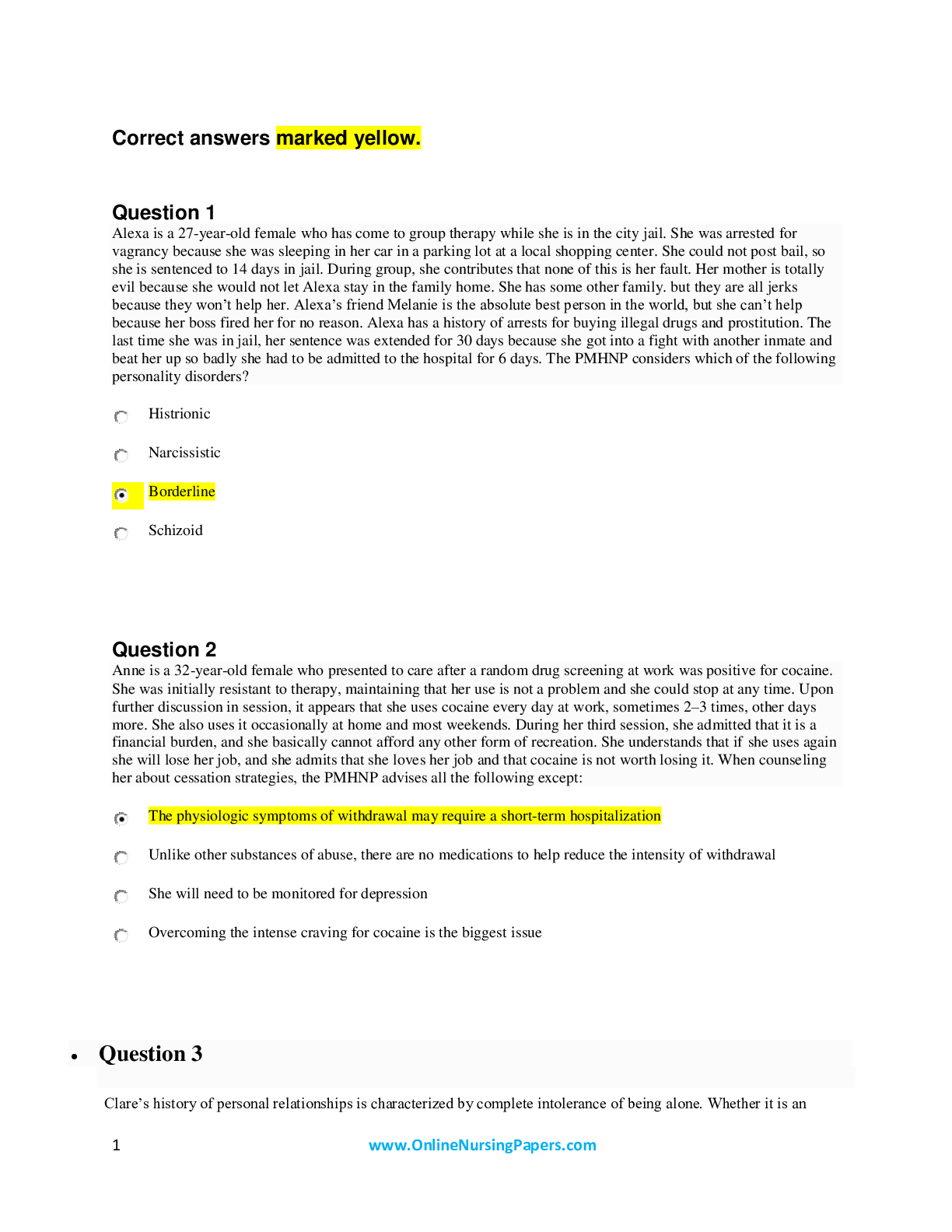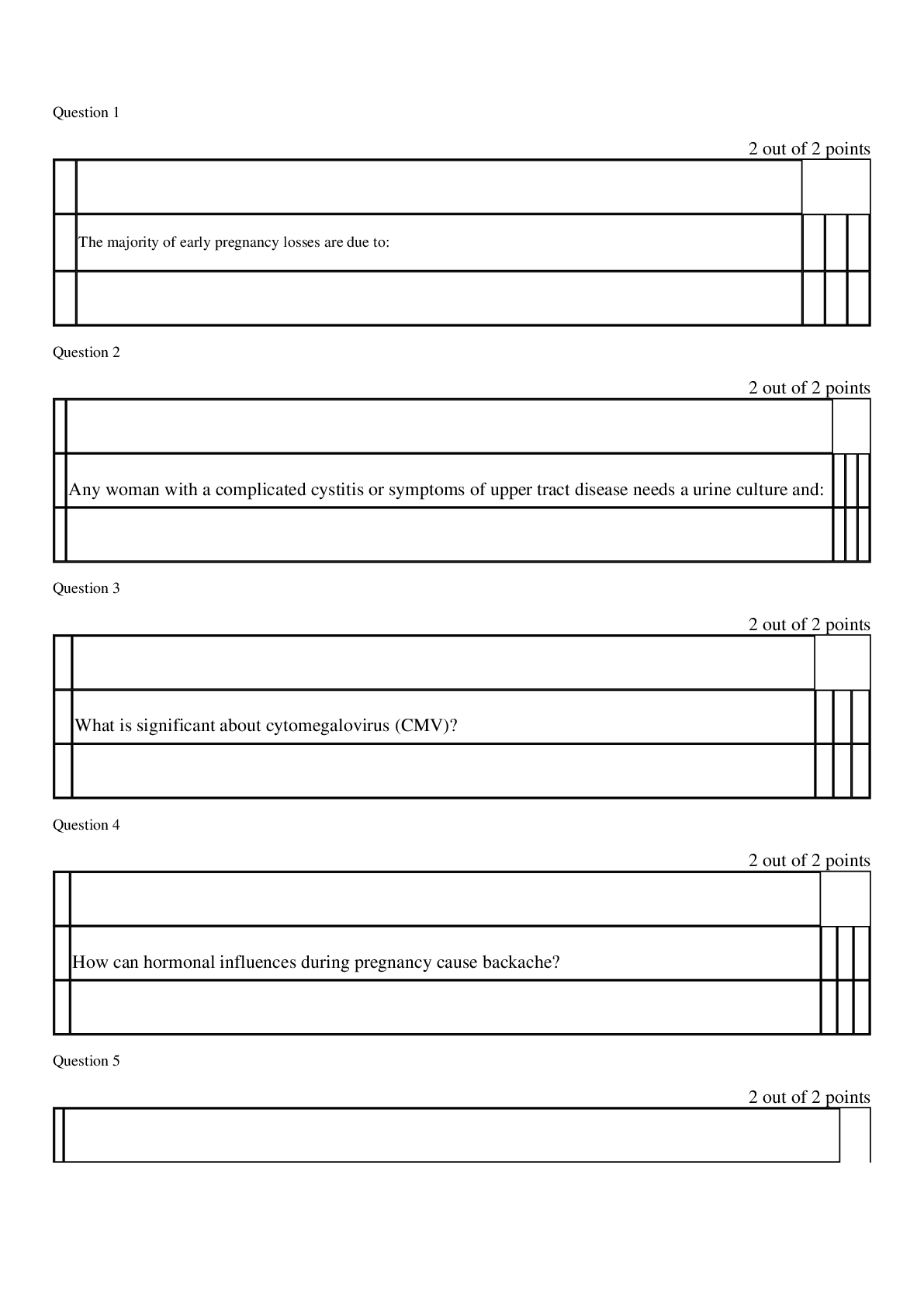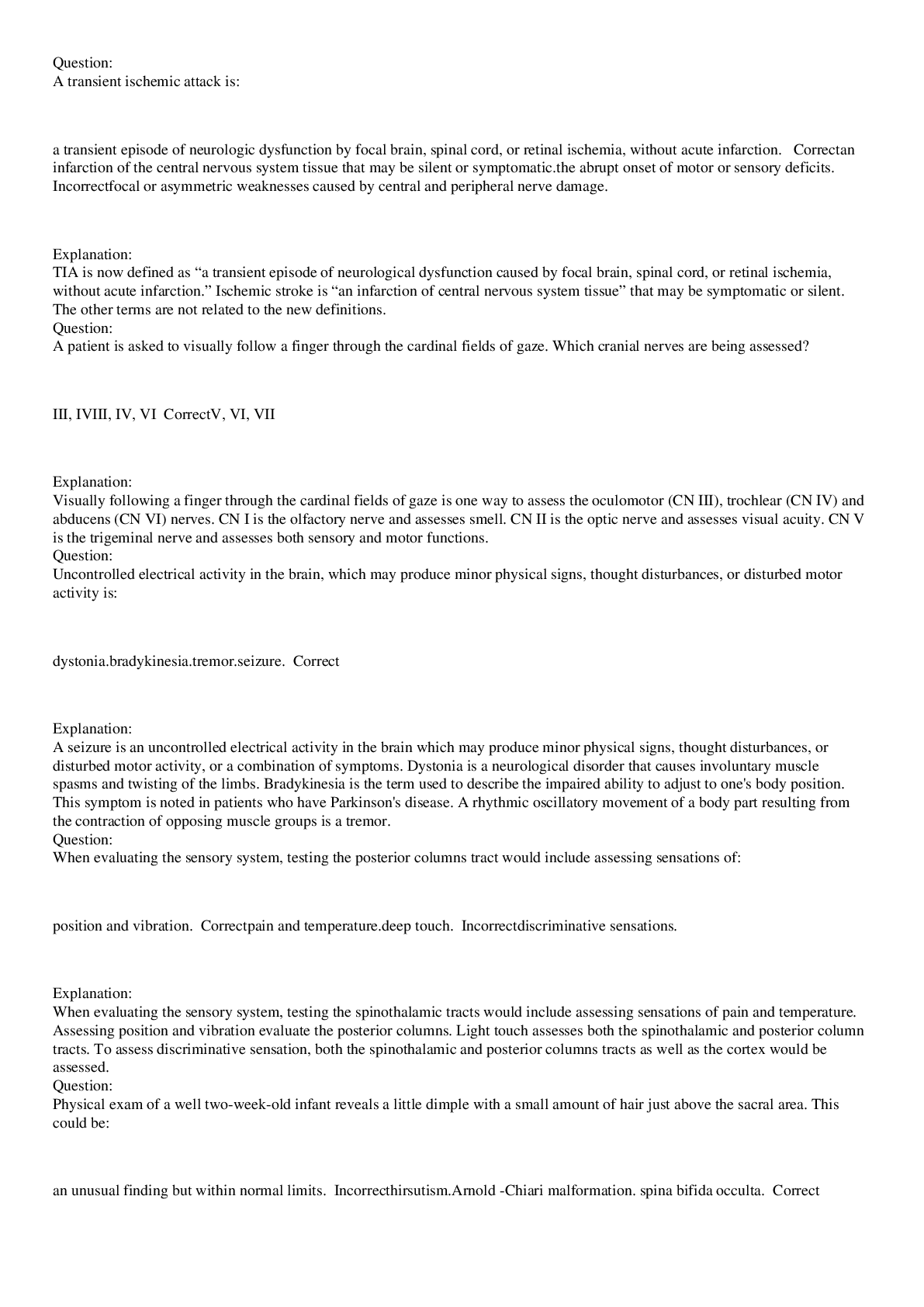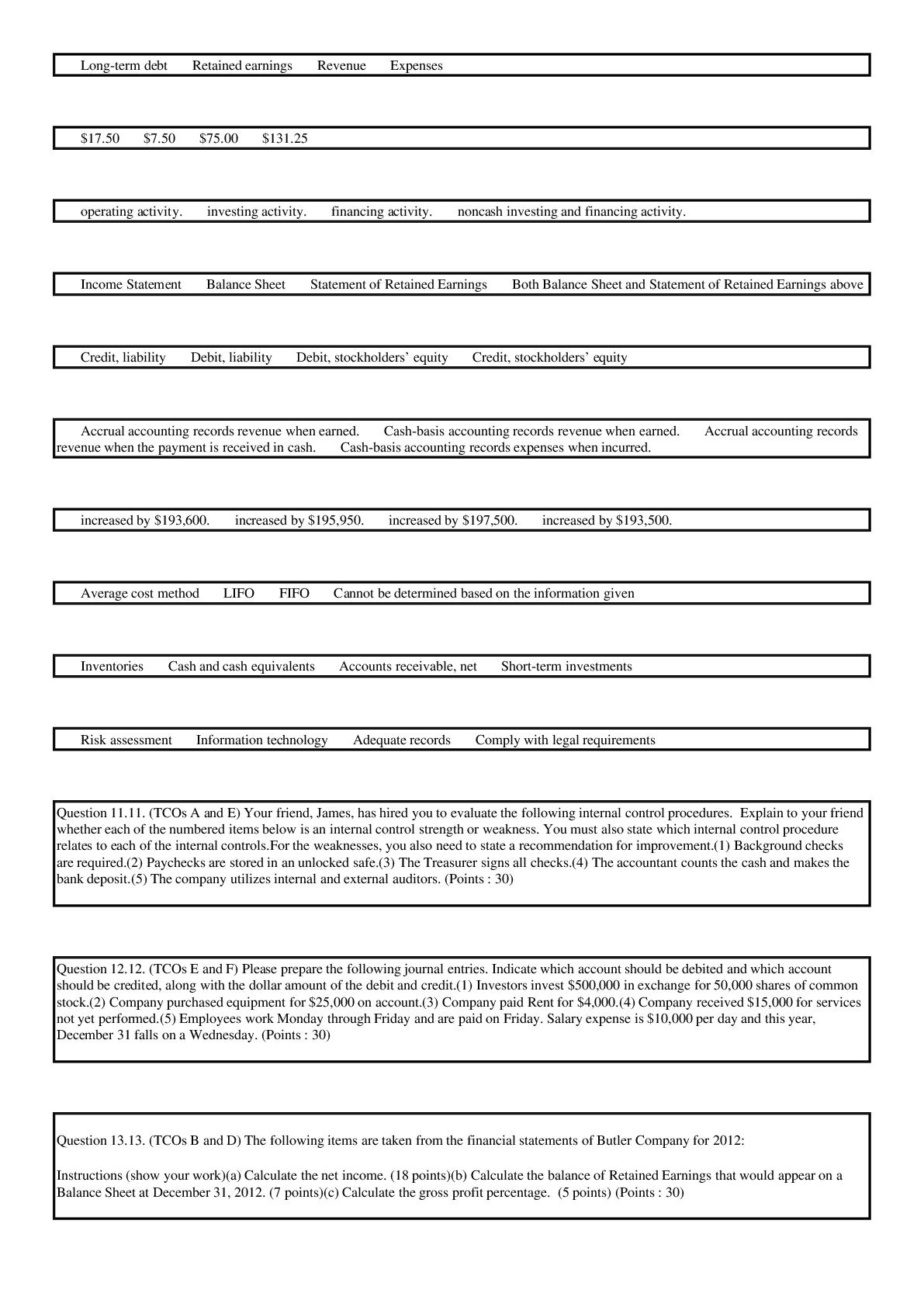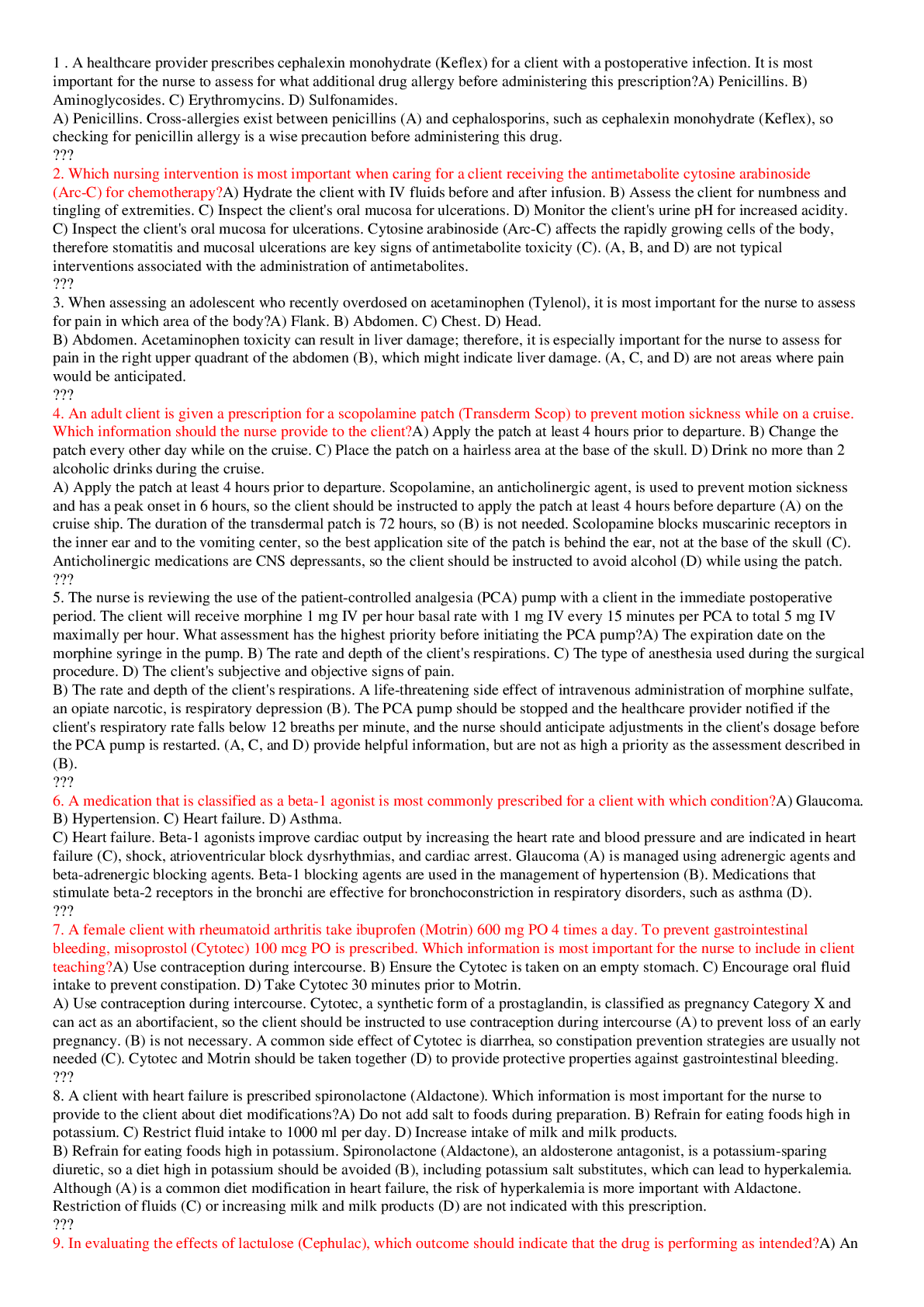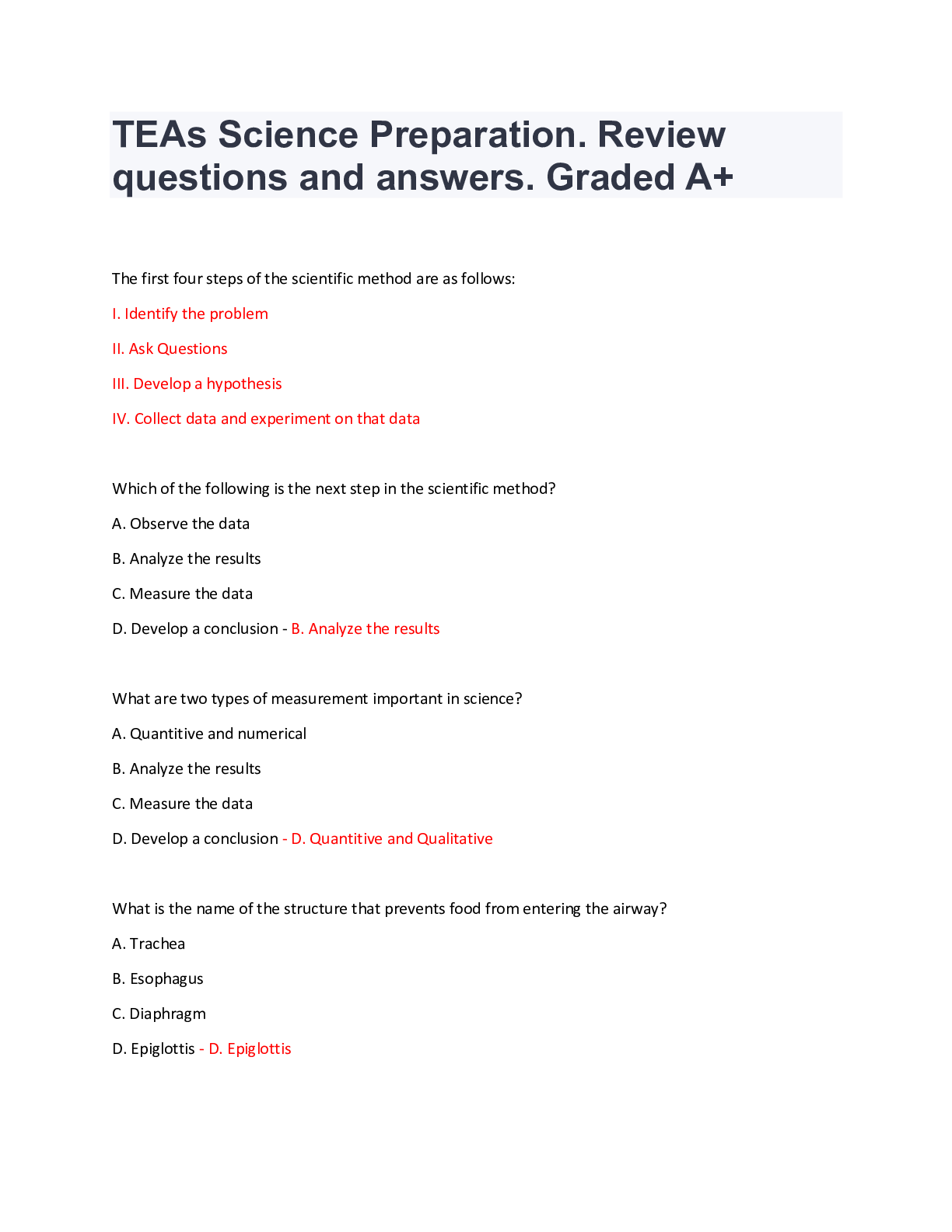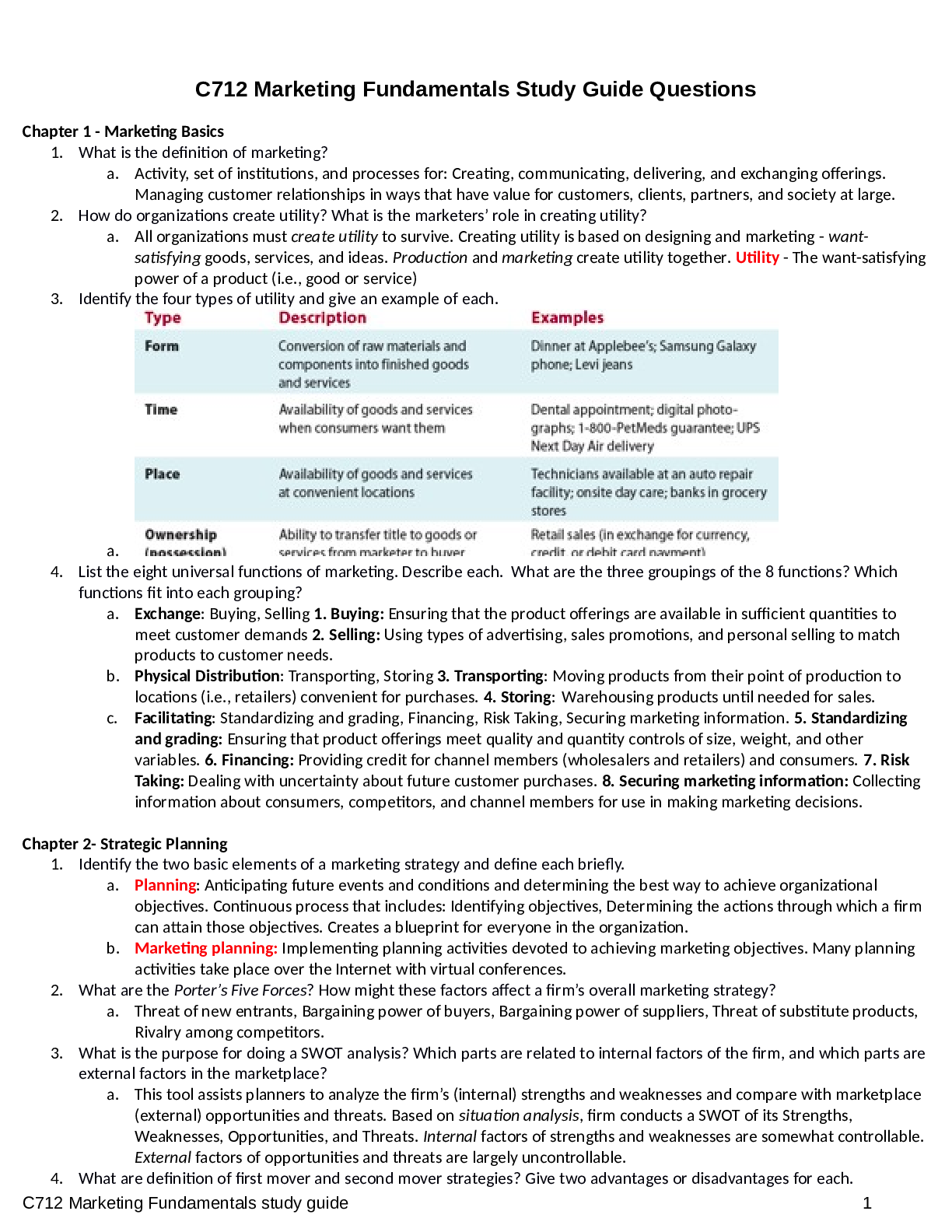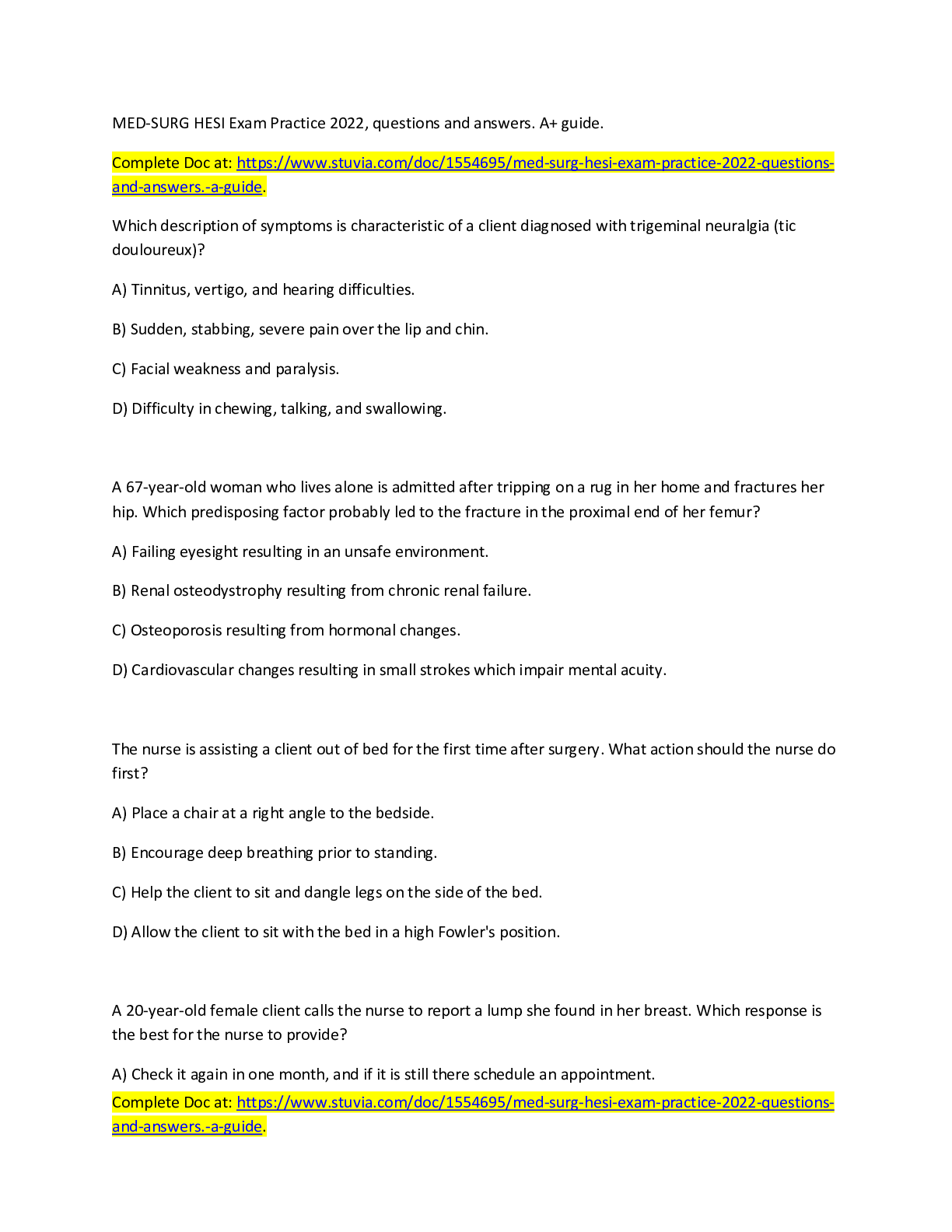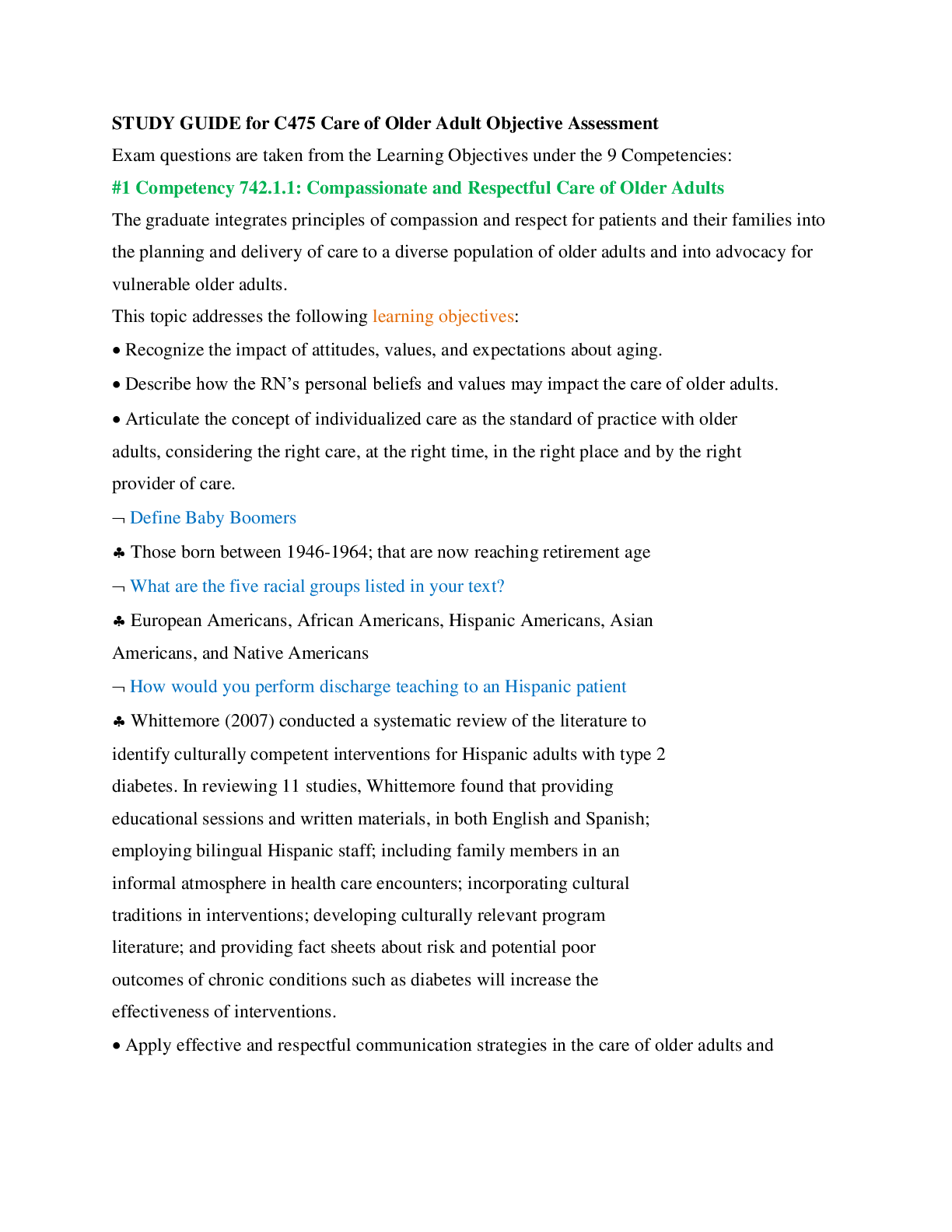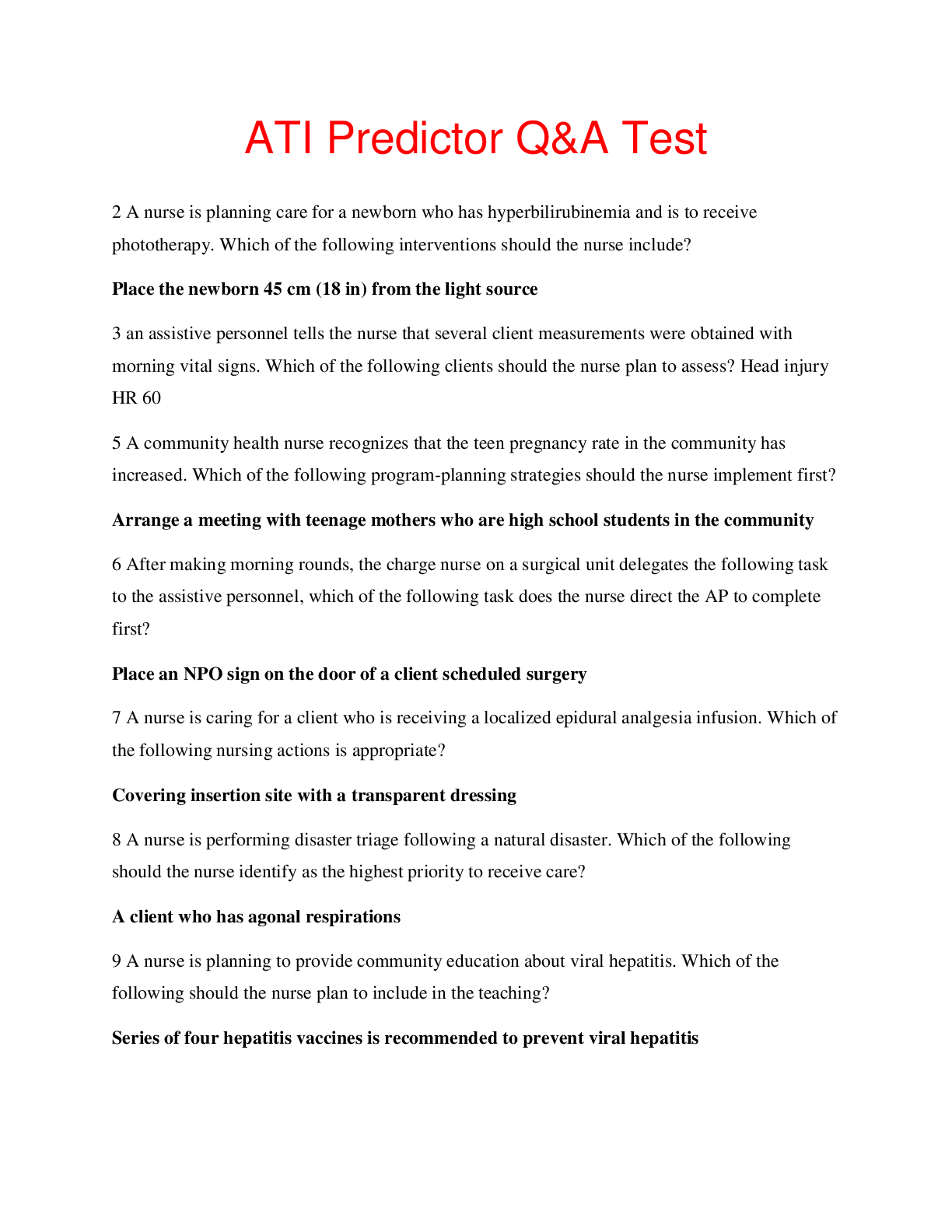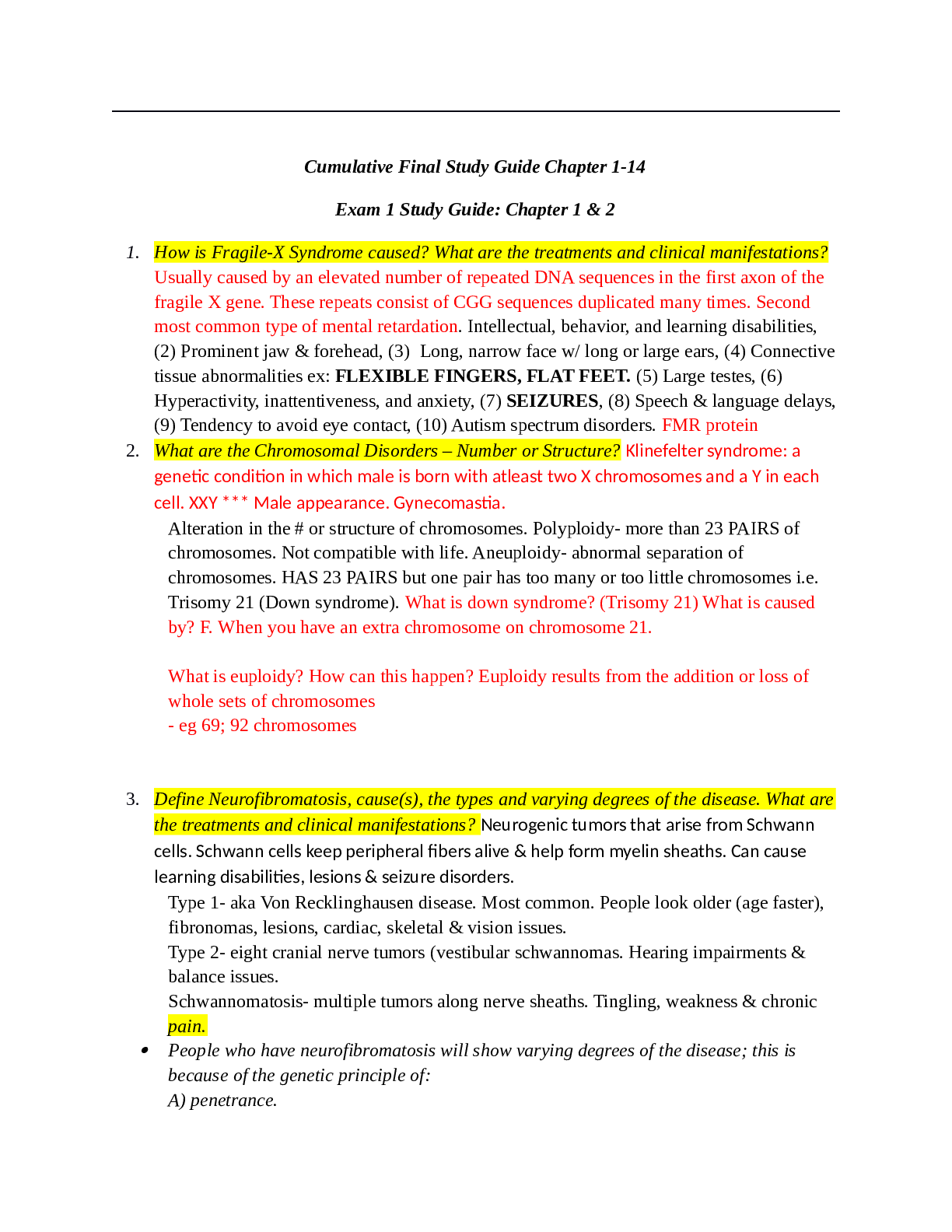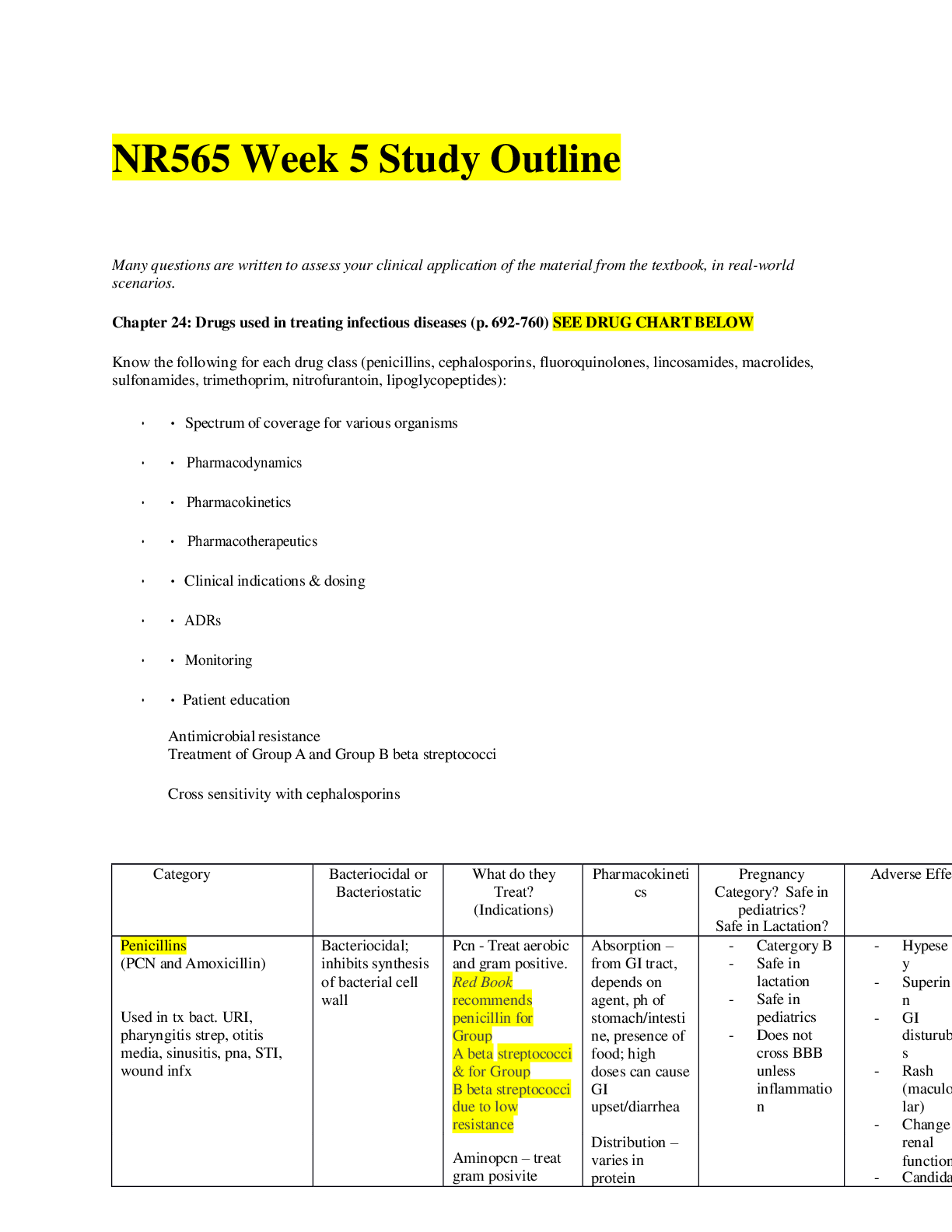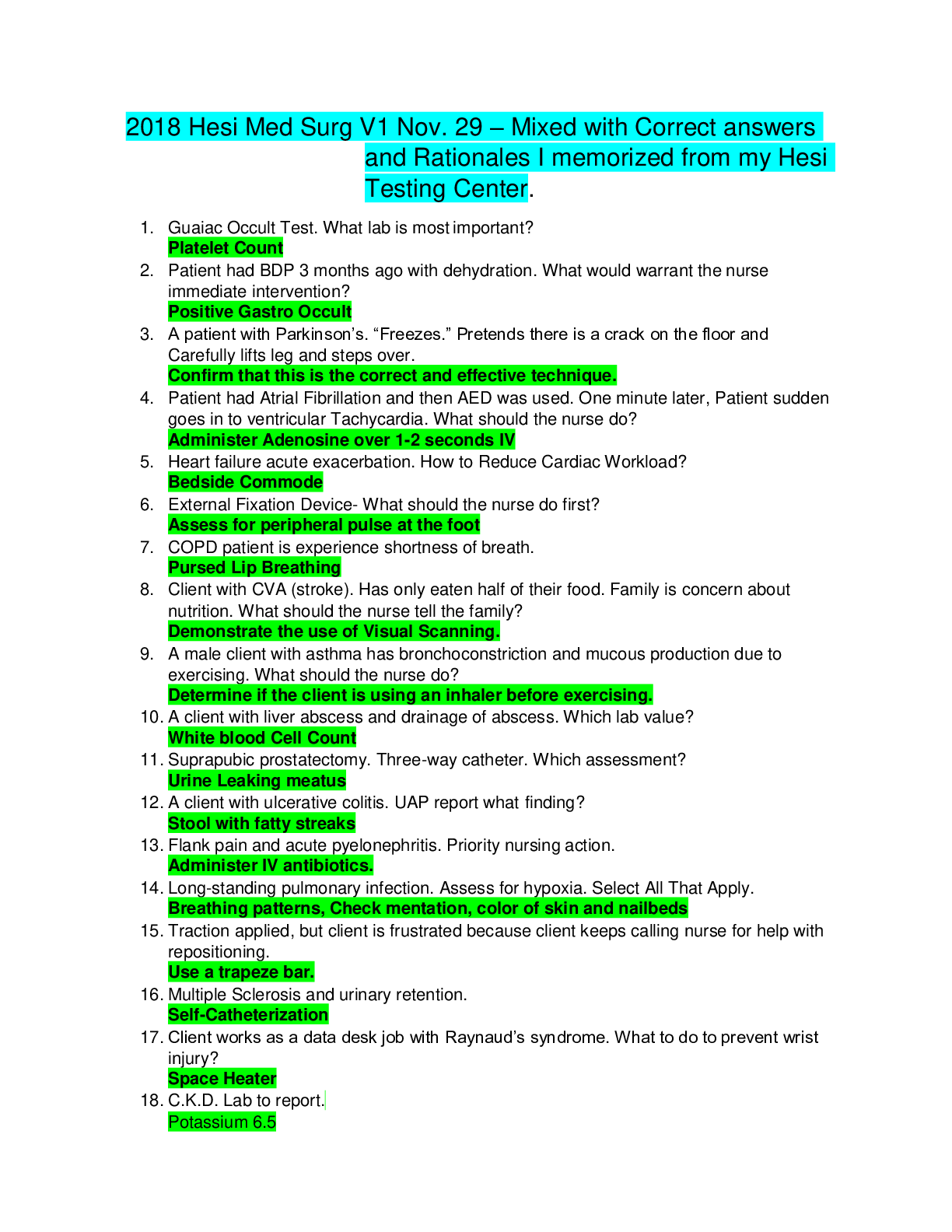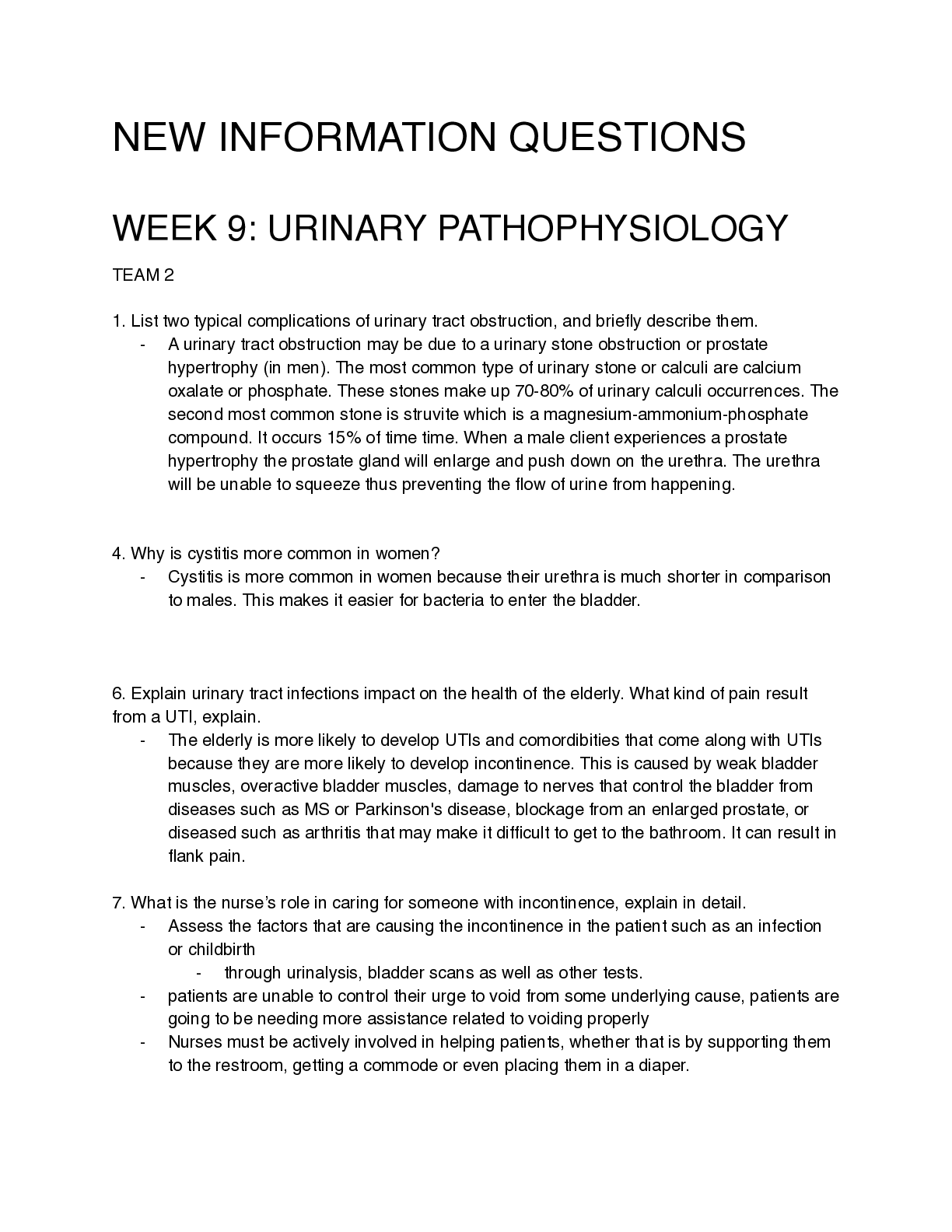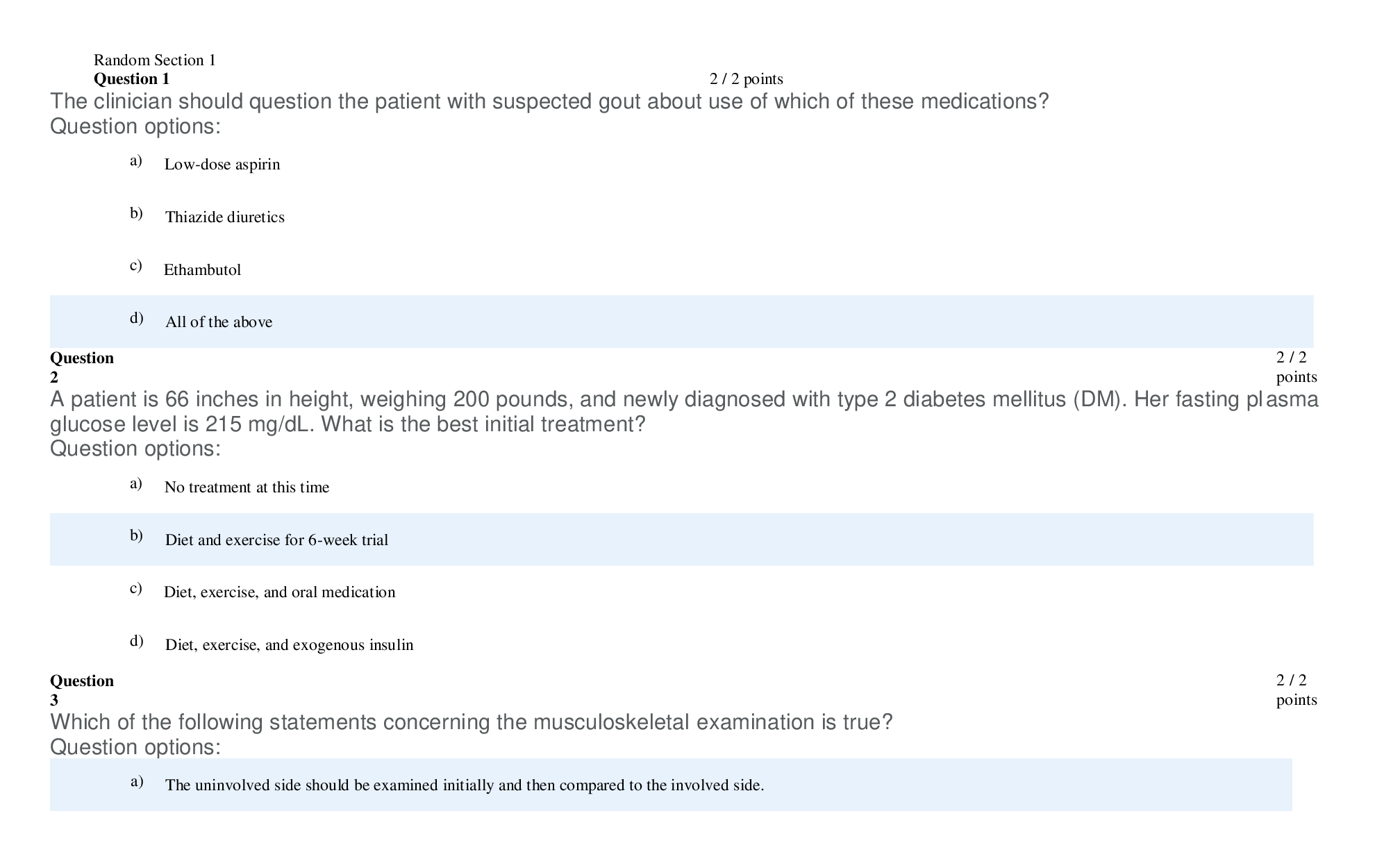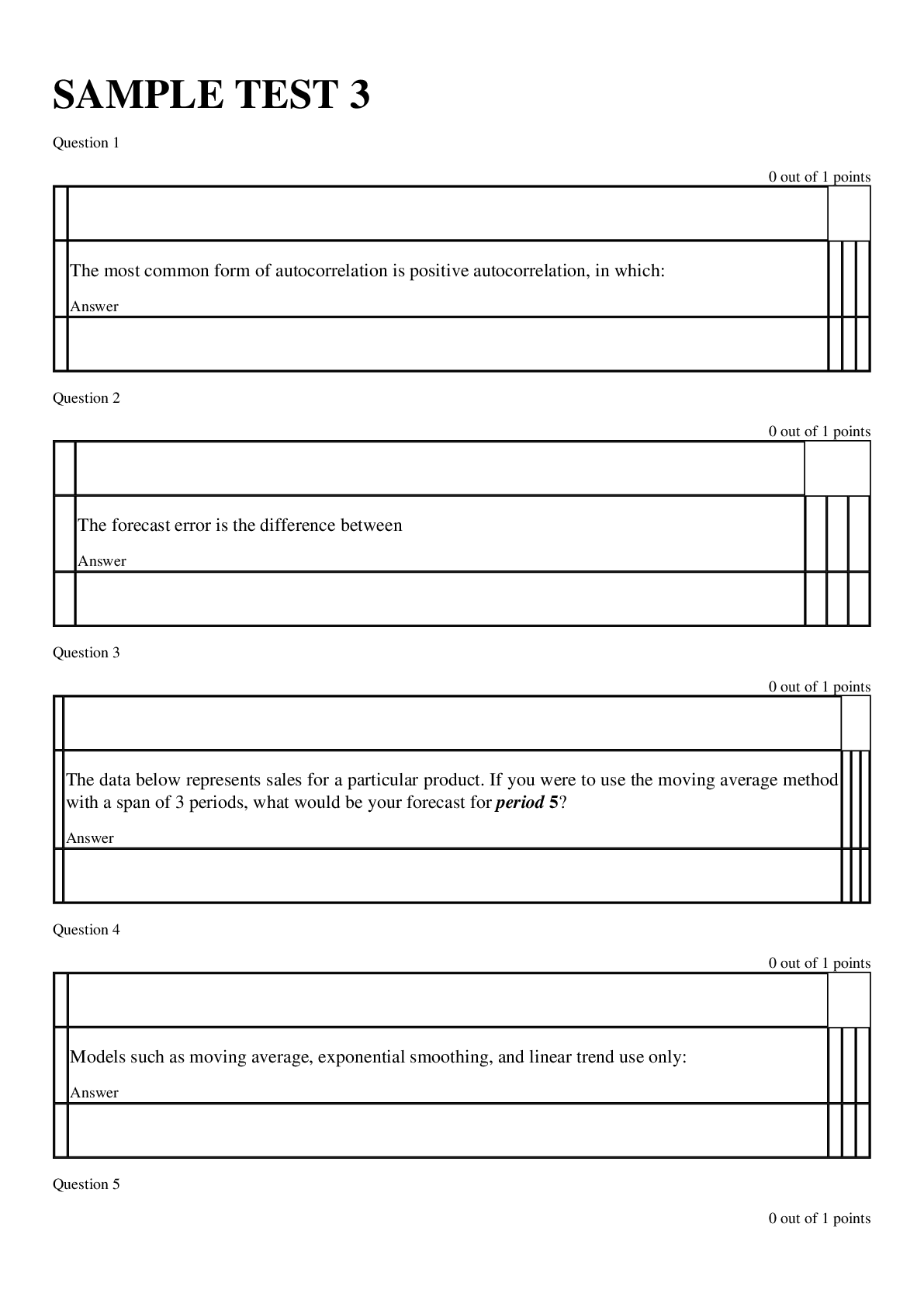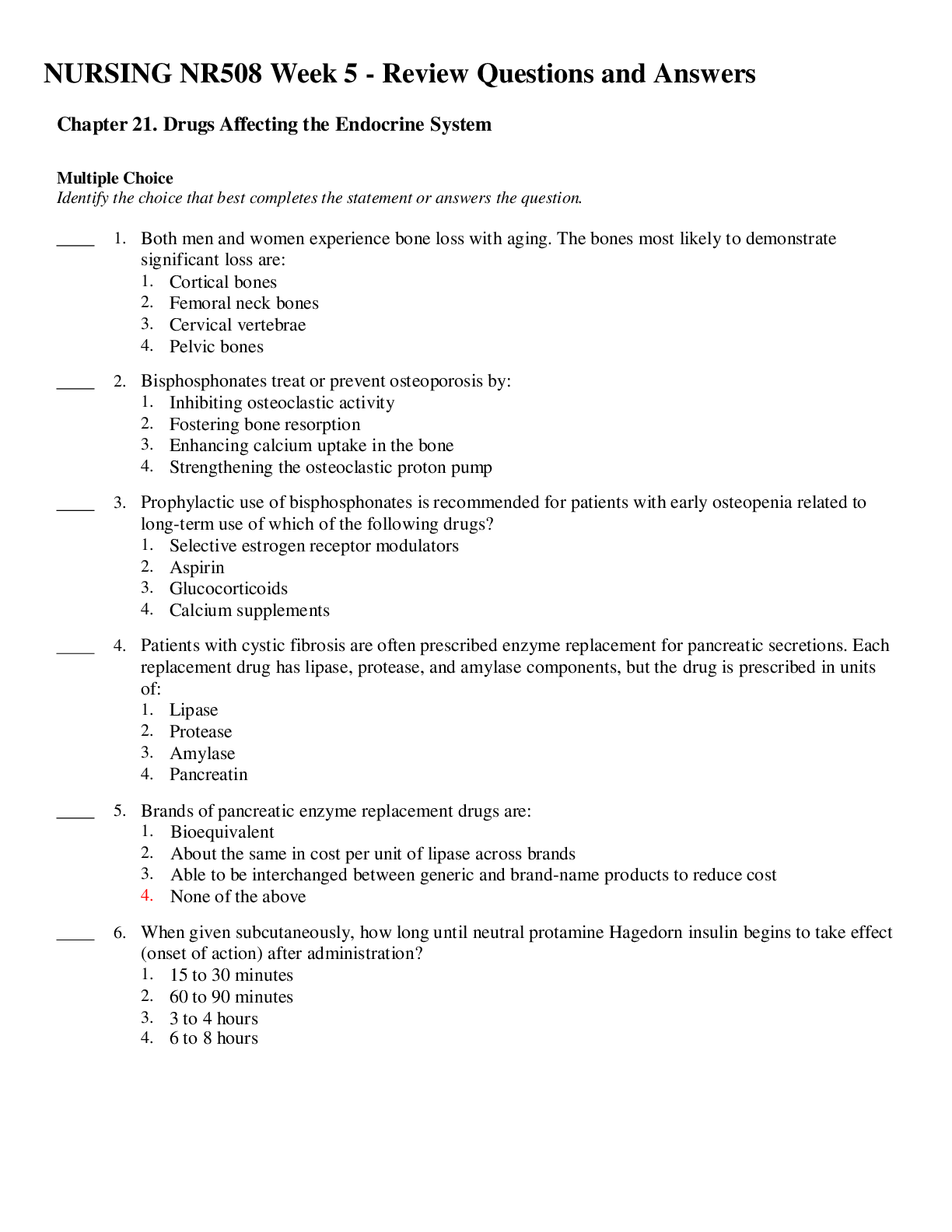Economics > STUDY GUIDE > ECON 2101 Chapter 10 Externalities Sec00 MULTIPLE CHOICE QUESTIONS AND ANSWERS. (All)
ECON 2101 Chapter 10 Externalities Sec00 MULTIPLE CHOICE QUESTIONS AND ANSWERS.
Document Content and Description Below
1. In a market economy, government intervention a. will always improve market outcomes. b. reduces efficiency in the presence of externalities. c. may improve market outcomes in the presence of ext... ernalities. d. is necessary to control individual greed. ANS: C DIF: 1 REF: 10-0 NAT: Analytic LOC: Markets, market failure, and externalities TOP: Externalities MSC: Applicative 2. In the absence of externalities, the "invisible hand" leads a market to maximize a. producer profit from that market. b. total benefit to society from that market. c. both equality and efficiency in that market. d. output of goods or services in that market. ANS: B DIF: 1 REF: 10-0 NAT: Analytic LOC: Markets, market failure, and externalities TOP: Externalities MSC: Applicative 3. The term market failure refers to a. a market that fails to allocate resources efficiently. b. an unsuccessful advertising campaign which reduces demand. c. ruthless competition among firms. d. a firm that is forced out of business because of losses. ANS: A DIF: 1 REF: 10-0 NAT: Analytic LOC: Markets, market failure, and externalities TOP: Externalities MSC: Definitional 4. Market failure can be caused by a. too much competition. b. externalities. c. low consumer demand. d. scarcity. ANS: B DIF: 1 REF: 10-0 NAT: Analytic LOC: Markets, market failure, and externalities TOP: Externalities MSC: Interpretive Chapter 10/Externalities 859 5. An externality is an example of a. a corrective tax. b. a tradable pollution permit. c. a market failure. d. Both a and b are correct. ANS: C DIF: 1 REF: 10-0 NAT: Analytic LOC: Markets, market failure, and externalities TOP: Externalities MSC: Applicative 6. An externality is the impact of a. society's decisions on the well-being of society. b. a person's actions on that person's well-being. c. one person's actions on the well-being of a bystander. d. society's decisions on the poorest person in the society. ANS: C DIF: 1 REF: 10-0 NAT: Analytic LOC: Markets, market failure, and externalities TOP: Externalities MSC: Definitional 7. The impact of one person's actions on the well-being of a bystander is called a. an economic dilemma. b. deadweight loss. c. a multi-party problem. d. an externality. ANS: D DIF: 1 REF: 10-0 NAT: Analytic LOC: Markets, market failure, and externalities TOP: Externalities MSC: Applicative 8. An externality a. results in an equilibrium that does not maximize the total benefits to society. b. causes demand to exceed supply. c. strengthens the role of the “invisible hand” in the marketplace. d. affects buyers but not sellers. ANS: A DIF: 1 REF: 10-0 NAT: Analytic LOC: Markets, market failure, and externalities TOP: Externalities MSC: Interpretive 9. An externality is a. the costs that parties incur in the process of agreeing and following through on a bargain. b. the uncompensated impact of one person's actions on the well-being of a bystander. c. the proposition that private parties can bargain without cost over the allocation of resources. d. a market equilibrium tax. ANS: B DIF: 1 REF: 10-0 NAT: Analytic LOC: Markets, market failure, and externalities TOP: Externalities MSC: Definitional 860 Chapter 10/Externalities 10. A cost imposed on someone who is neither the consumer nor the producer is called a a. corrective tax. b. command and control policy. c. positive externality. d. negative externality. ANS: D DIF: 1 REF: 10-0 NAT: Analytic LOC: Markets, market failure, and externalities TOP: Externalities KEY: Definitional 11. An externality arises when a person engages in an activity that influences the well-being of a. buyers in the market for that activity and yet neither pays nor receives any compensation for that effect. b. sellers in the market for that activity and yet neither pays nor receives any compensation for that effect. c. bystanders in the market for that activity and yet neither pays nor receives any compensation for that effect. d. Both (a) and (b) are correct. ANS: C DIF: 1 REF: 10-0 NAT: Analytic LOC: Markets, market failure, and externalities TOP: Externalities MSC: Definitional 12. An externality exists whenever a. the economy cannot benefit from government intervention. b. markets are not able to reach equilibrium. c. a firm sells its product in a foreign market. d. a person engages in an activity that influences the well-being of a bystander and yet neither pays nor receives payment for that effect. ANS: D DIF: 2 REF: 10-0 NAT: Analytic LOC: Markets, market failure, and externalities TOP: Externalities MSC: Definitional 13. When externalities are present in a market, the well-being of market participants a. and market bystanders are both directly affected. b. and market bystanders are both indirectly affected. c. is directly affected, and market bystanders are indirectly affected. d. is indirectly affected, and market bystanders are directly affected. ANS: C DIF: 2 REF: 10-0 NAT: Analytic LOC: Markets, market failure, and externalities TOP: Externalities MSC: Analytical Chapter 10/Externalities 861 14. Dog owners do not bear the full cost of the noise their barking dogs create and often take too few precautions to prevent their dogs from barking. Local governments address this problem by a. making it illegal to "disturb the peace." b. having a well-funded animal control department. c. subsidizing local animal shelters. d. encouraging people to adopt cats. ANS: A DIF: 1 REF: 10-0 NAT: Analytic LOC: Markets, market failure, and externalities TOP: Externalities MSC: Applicative 15. Which of the following statements about a well-maintained yard best conveys the general nature of the externality? a. A well-maintained yard conveys a positive externality because it increases the home's market value. b. A well-maintained yard conveys a negative externality because it increases the property tax liability of the owner. c. A well-maintained yard conveys a positive externality because it increases the value of adjacent properties in the neighborhood. d. A well-maintained yard cannot provide any type of externality. ANS: C DIF: 2 REF: 10-0 NAT: Analytic LOC: Markets, market failure, and externalities TOP: Externalities MSC: Applicative 16. Since restored historic buildings convey a positive externality, local governments may choose to a. regulate the demolition of them. b. provide tax breaks to owners who restore them. c. increase property taxes in historic areas. d. Both a and b are correct. ANS: D DIF: 2 REF: 10-0 NAT: Analytic LOC: Markets, market failure, and externalities TOP: Externalities MSC: Applicative 17. All externalities a. cause markets to fail to allocate resources efficiently. b. cause equilibrium prices to be too high. c. benefit producers at the expense of consumers. d. cause equilibrium prices to be too low. ANS: A DIF: 2 REF: 10-0 NAT: Analytic LOC: Markets, market failure, and externalities [Show More]
Last updated: 1 year ago
Preview 1 out of 82 pages
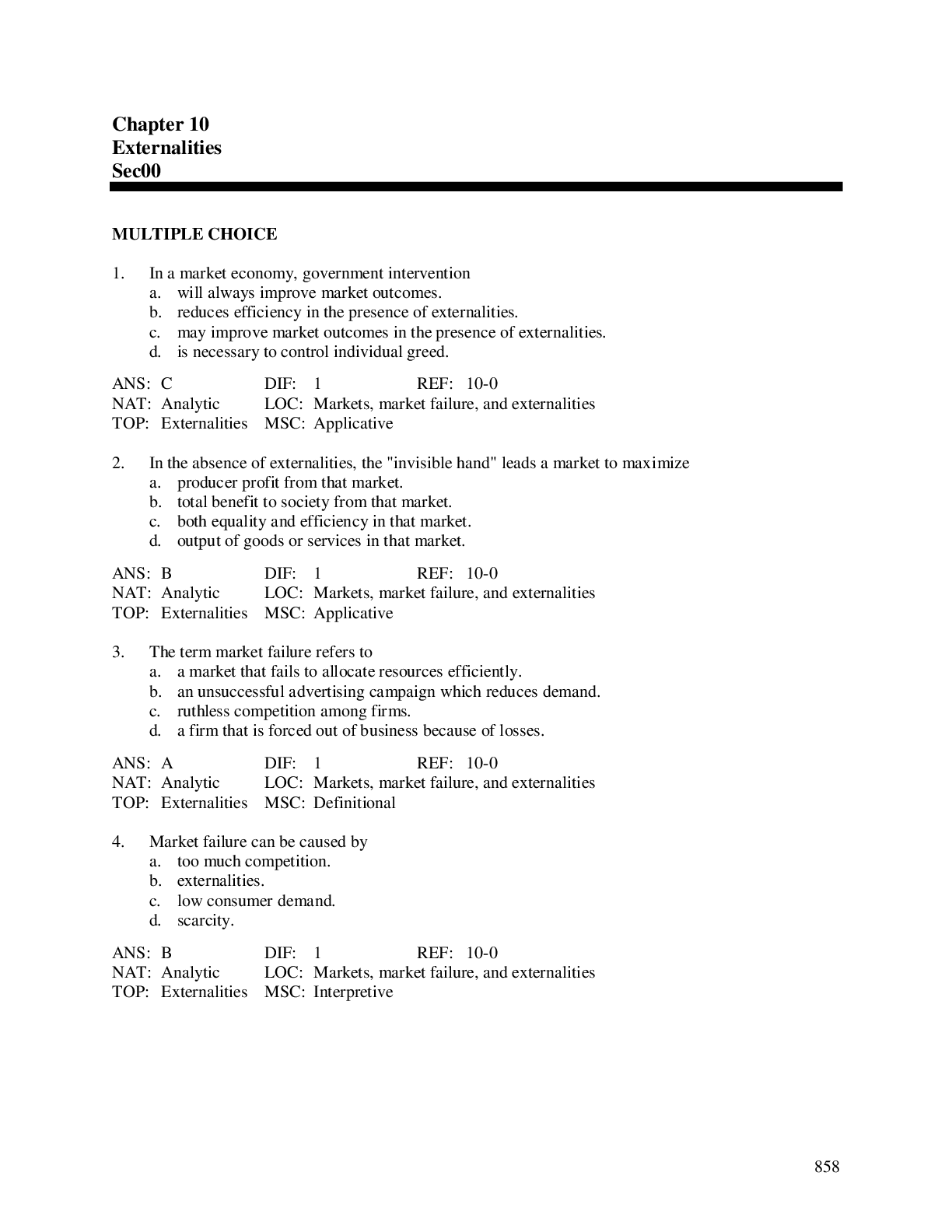
Reviews( 0 )
Document information
Connected school, study & course
About the document
Uploaded On
Oct 04, 2020
Number of pages
82
Written in
Additional information
This document has been written for:
Uploaded
Oct 04, 2020
Downloads
0
Views
45

